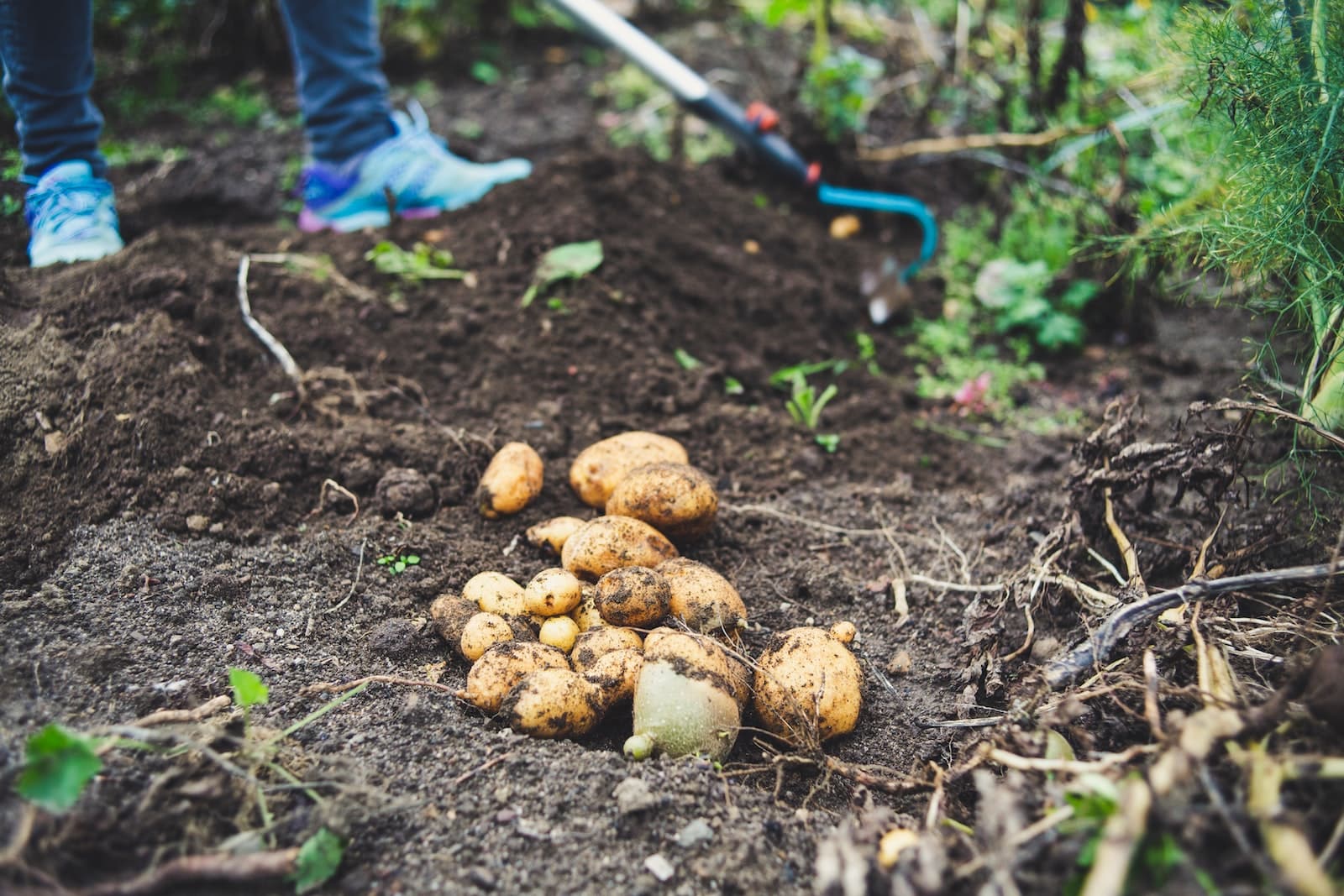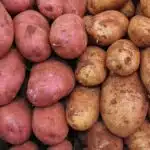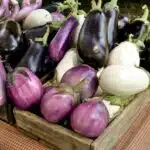Potatoes: the staple of every home cook’s pantry. Whether you’re whipping up a hearty stew or baking a creamy casserole, potatoes are always the perfect addition to complete any dish. But what if I told you that you could take your potato game to the next level by growing your own? Say goodbye to boring store-bought spuds and hello to homegrown, organic potatoes!
Gardening doesn’t have to be tedious or difficult – with our 7 easy steps on how to grow potatoes at home, anyone can become an expert farmer in no time. From finding the right soil and fertilizer to harvesting your crop, we’ll cover all the tips and tricks you need for success! No green thumb is required!
So if you’re ready to revolutionize your potato game and start growing your own organic potatoes at home, then keep reading. You’ll be amazed at just how simple it is – with just a little bit of patience and effort, soon enough you’ll be reaping the rewards of your very own homegrown potatoes!
1. Choose The Right Potato Variety
Growing potatoes at home can be a rewarding experience and knowing the right variety to choose is an important first step! When selecting a potato for your garden, consider the climate in your area. Potatoes come in many varieties, all of which have different needs when it comes to temperature and soil type. Choose a variety that matches your local conditions so you can get the best results from your own backyard.
Once you’ve chosen the best potato variety for you, it’s time to prepare the soil. This will ensure that your plants are getting all the nutrients they need to thrive. Begin by testing your soil for pH levels and adding amendments like compost or fertilizer as needed. You may also need to loosen up heavy clay soils with sand or peat moss before planting.
Finally, it’s time to start planting! Depending on how much space you have available, you can either dig individual holes or create mounds of soil for each plant. If using mounds, make sure they are spaced far enough apart so that there is plenty of room for root growth without overcrowding. With just a little bit of preparation and care, you can be well on your way to harvesting delicious potatoes from your own backyard!
2. Prepare The Soil
Preparation of the soil is an essential step to grow potatoes at home. It’s important to make sure that your soil has all the nutrients it needs to help your potatoes flourish. To get the best results, here are some steps you can take:
• Preparing the soil:
o Test the pH level and adjust if necessary
o Till in compost or manure for additional nutrients
• Feeding your plants:
o Add a layer of mulch around the potato plants
o Fertilize regularly with a nitrogen-rich fertilizer such as fish emulsion or seaweed extract
With these steps taken, you’ll be well on your way to producing a bumper crop of potatoes. Your soil will be nutrient-rich and well-conditioned for optimum growth. Plus, adding mulch and fertilizing with nitrogen-rich products will give your garden just what it needs for maximum yield. By taking these simple steps, you can ensure that you have everything needed to successfully grow potatoes in your own backyard!
3. Plant The Potato Tubers
As the old saying goes, “patience is a virtue”, and this is especially true when it comes to growing potatoes at home. After you have prepared the soil, it is time to plant your potato tubers. This can be done in two different ways: directly in the ground or in a container such as a grow bag. For either method, you will need some potato tubers that have been allowed to sprout eyes (or shoots), which can be done by leaving them in an open box of soil for a few weeks before planting.
When planting your potato tubers directly into the ground, ensure that they are spaced evenly apart at least six inches deep and 12 inches apart. Make sure to cover them with soil and lightly firm down afterwards. If you are using containers, fill them up with compost or potting mix and place three or four potato tubers into each one, then cover with compost or potting mix again until only the shoots are visible.
With both methods of planting complete, it’s time for the next step – watering and feeding your potato plants! It’s important to water your plants regularly throughout the growing season so that they don’t dry out; make sure not to over-water however as this can cause blight problems on the leaves. Feeding your plants should also be done every couple of weeks using a high-potash fertiliser such as seaweed extract or tomato feed to encourage healthy growth.
4. Water And Feed Your Potato Plants
As the sun rises over the garden, it’s time to bring your potatoes to life. Like a gardener carefully tending their prized plants, you’ll need to water and feed them to ensure they reach their full potential. In this section, let’s explore how to help your potato plants thrive.
Water is essential for growing potatoes; without it, the plants won’t be able to absorb necessary nutrients from the soil. To keep your potato plants hydrated and healthy, use a watering can or hose with a gentle sprayer attachment to avoid damaging the delicate foliage. Make sure you water consistently throughout the summer months as potatoes require at least one inch of water per week. Additionally, add organic compost or manure every four weeks to provide important nutrients for your potatoes.
With careful attention and maintenance, you’ll find that providing enough water and nutrition will make all the difference in helping your potatoes grow successfully. As you give them just what they need to stay happy and healthy, you’ll have delicious potatoes in no time! And when that happens, all of your hard work will have been worth it – so don’t forget to take a well-deserved break before tackling the next step: keeping your plants weed-free!
5. Keep Your Plants Weed-Free
Potato growth is a rewarding experience and according to the National Gardening Association, over a third of all households in the United States have at least some kind of vegetable garden. Growing potatoes at home can be an especially rewarding experience, as it will yield a delicious crop with minimal effort. In order to ensure success in your potato-growing endeavor, it’s important to keep your plants weed-free.
Weeds can compete with your potato plants for water and nutrients, and can also provide habitat for pests that could damage or even kill your potato plants. It’s important to remove weeds around your potato plants regularly in order to give them the best chance at thriving. Regularly removing weeds can also help prevent the spread of invasive species and diseases that could further hamper the growth of your potatoes.
Fortunately, there are several methods you can use to keep weeds out of your potato patch. Mulching around young seedlings is an effective way to prevent weed growth without risking damage to the fragile roots of young plants. If you need to remove existing weeds manually, using a hoe or hand trowel is usually enough – just be sure not to disturb any nearby potato roots while doing so! With these tips in mind, keeping your potato patch free from weeds should be relatively easy – making sure that you end up with a healthy crop of tasty potatoes by harvest time.
6. Support Your Potato Vines
The potato vines are like a vineyard, stretching their tendrils around the soil. Supporting them in their journey is essential to get an abundant crop of potatoes. As they reach towards the sun, the gardener must help provide sustenance and structure for them to thrive.
So how can you support your potato vines? First, use stakes or cages to keep your plants upright and off the ground. This helps prevent rot and disease from invading the soil and gives your plants room to breathe and grow. Additionally, tying the vines loosely to stakes with soft string or yarn can increase airflow and reduce moisture build-up on the leaves.
Lastly, consider using floating row covers over the plants for extra protection against pests or adverse weather conditions. This helps maintain temperature control while keeping pests away from your precious potato plants. With these simple steps, you’ll be able to give your potatoes the best chance at success so that you can enjoy a bountiful harvest at home!
7. Mulch Around The Potato Plants
Mulching around the potato plants is akin to wrapping a blanket of warmth around them. It’s a way to keep them comfortable and cuddled, free from any harshness of the environment. It is truly an act of love. Here are four ways to ensure that your potatoes get enough mulch:
- Utilize natural mulches like straw, hay, or grass clippings;
- Use composted leaves or manure;
- Spread the mulch in a thin layer over the soil surface;
- Make sure there is no direct contact between the mulch and the plant stems.
Mulching helps keep weeds down, reduces water evaporation from the soil, and keeps the soil temperatures consistent for your potato plants throughout its growth cycle. In addition, it also suppresses diseases by preventing spores from splashing onto foliage when it rains or when you water your plants with a hose.
These protective measures will help your potato plants reach their full potential and provide you with a bountiful harvest in due time. With these tips combined with proper sunlight and nutrients for your potato plants, you will soon be on your way to harvesting delicious potatoes in no time!
8. Harvest Your Potatoes
Reaping the rewards of your hard work is something that every gardener looks forward to. Like a pot of gold at the end of a rainbow, harvesting your potatoes brings joy and satisfaction. After following all the steps and patiently waiting for your potatoes to grow, it’s time to reap the benefits.
The potato harvest usually happens in late summer or early fall when the foliage turns yellow and begins to die back. Carefully dig up around the plant with a spade or garden fork while avoiding cutting into any potatoes. After loosening the soil, gently pull up each plant and inspect them for potatoes. Make sure you take care not to bruise or damage them during this process. Most mature potatoes will separate from the stem easily without being damaged, but if they don’t then carefully cut off any tubers clinging to it using gardening shears or scissors.
Once you’ve harvested all your potatoes, it’s time for proper storage so that you can enjoy them all winter long! Potatoes need cool temperatures (40-50°F) and high humidity (90-95%) in order to remain fresh for extended periods of time. The best place for storing them is a dark area such as a basement or root cellar where these conditions can be easily maintained. Be sure to sort through your potatoes before storing them, discarding any that are soft or have visible signs of damage or disease as these won’t last long in storage. With proper care and maintenance, you’ll be able enjoy homegrown potatoes year round!
9. Store Your Potatoes
It’s a simple process, really. Plant the potatoes, watch them grow, then harvest and store them. Like a well-oiled machine, the process can make gardening seem effortless.
Once the potatoes have been harvested, it’s time to move onto storing them; the next step in this age-old tradition. It is important that potatoes are stored correctly in order to maintain their flavor and texture. The key to successful potato storage is keeping them cool, dark and dry – as if they were tucked away in an old-fashioned root cellar!
Whether you’re storing a large amount of potatoes or just a few, there are methods to ensure they remain fresh and delicious for as long as possible. For small amounts of potatoes, the best option is to place them into paper bags or cardboard boxes with ventilation holes. A cool basement or garage away from direct sunlight also helps keep temperatures steady and maintains moisture levels. For larger batches of potatoes, it is recommended to use plastic containers with airtight lids or even wooden crates such as those used for apples.
With proper storage techniques in place, you’ll be able to enjoy your homegrown potatoes for months on end! Knowing how to store your harvest will help protect your crop from common potato diseases and keep your family enjoying nutritious meals all season long.
10. Common Potato Diseases
The tenth step to growing potatoes at home is dealing with common potato diseases. This can be a daunting task, especially since potatoes are susceptible to over 120 different diseases. However, with proper knowledge and care, you can protect your crops from most of these ailments.
One surprising statistic is that some potato diseases can reduce yields by as much as 50%. This underscores the importance of understanding the various illnesses that can affect your crop and how to prevent them.
By taking proactive steps like rotating crops, using disease-resistant varieties and keeping your soil healthy, you can greatly reduce the chances of your potatoes becoming sick. Additionally, learning about the signs and symptoms of each disease will help you identify an issue quickly so you can take the necessary steps to protect your crop.
Taking these preventive measures will go a long way in ensuring a successful harvest for your home-grown potatoes and will help pave the way for future success in planting other vegetables. Pests are another potential threat to consider when growing potatoes at home.
11. Pests That Attack Potatoes
Like an unwelcome guest, pests can sneak into your potato patch and cause havoc. It’s important to be aware of the common pests that attack potatoes so you can take steps to prevent them.
The most common pest found on potatoes is the Colorado potato beetle. These small, yellow-striped beetles feed on the leaves of potato plants and can quickly defoliate a plant if left unchecked. Handpicking these beetles off the plants and crushing them is one of the best ways to keep their numbers under control.
In addition to beetles, slugs and aphids are also known to feed on potatoes. Slugs can be deterred by setting up barriers around your garden bed such as copper tape or beer traps, while aphids can be managed by spraying neem oil or introducing beneficial insects such as ladybugs or lacewings into the area.
Taking the time to learn about these potential threats and proactively managing them will help ensure your potatoes have a healthy start in life and provide you with a bumper crop come harvest time.
12. Companion Planting With Potatoes
Did you know that over 4,000 varieties of potatoes exist worldwide? It’s no wonder why potatoes are such a popular vegetable in gardens everywhere.
One way to get the most out of your potato garden is to practice companion planting. Companion planting is when you pair compatible plants together in order to increase their growth and yield. For example, planting onions or garlic close to your potatoes can help keep pests at bay. Plus, certain herbs like rosemary and oregano can help balance the soil’s pH levels and attract beneficial insects, which can increase the health of your potato garden even more!
Composting can also be a great companion for potatoes. Potatoes need plenty of organic matter in order to thrive, so adding composted material will ensure that they get all the nutrients they need. Adding mulch around the base of your potato plants will also help retain moisture and protect them from weeds.
With these tips in mind, you’ll be well on your way to growing a successful crop of potatoes at home! Now let’s take a look at the different types of potatoes that are available to choose from…
13. Types Of Potatoes
When you decide to grow potatoes at home, it’s important to know the different types of potatoes available. Potatoes come in all shapes, sizes, and colors – from the small, yellow-skinned fingerling potato to the large, white russet potato. Here is an example of how one family grew potatoes in their backyard. The family chose four varieties of potatoes from a local garden center: fingerling, sweet potato, red-skinned, and russet. They planted each type in a separate container and used companion planting with rosemary for extra flavor.
No matter which type of potato you choose to plant in your backyard garden, there are several common traits that inform their growth potential. All types of potatoes will need plenty of water and full sun exposure. Additionally, some types can be harvested early while others have a longer growing season. Here is a list of some popular types of potatoes:
• Fingerling – small, oval shaped potatoes with yellow skin
• Sweet Potato – purple or orange-fleshed tubers
• Red-skinned – oblong shape with thin red skin
• Russet – large spud with brown skin
When you’re ready to harvest your potatoes make sure you give them enough time to mature fully before digging them up! Each variety has its own unique characteristics that make it special; whether you’re looking for a high yielding crop or something fun to experiment with in the garden, there’s sure to be a perfect potato for every gardener out there!
Fertilizing your homegrown potatoes properly is essential for optimal growth. With the right mix of nutrients and minerals your plants will thrive…
14. Fertilizing Potatoes
Fertilizing potatoes is like giving a plant its favorite meal. A balanced diet of essential nutrients gives the potato plants what they need to thrive and produce a substantial harvest.
The first step in fertilizing potatoes is to create an ideal growing environment. Adding compost or aged manure to the soil will help retain moisture and provide nutrients for the plants. Additionally, supplementing with fish emulsion or other organic fertilizer can boost growth even further. It’s important to consider how much soil your potato plants will need; this will determine how much fertilizer you should add.
When it comes time to fertilize, make sure you spread the fertilizer evenly throughout your potato patch and avoid clumping it on top of any one area. This will ensure that each plant gets enough nutrition and won’t miss out on any vital nutrients from the fertilizer. Be careful not to overfertilize, however, as too much can cause stunted growth and weak production.
By properly fertilizing your potatoes, you are giving them a nutrient-rich environment in which they can grow their best. Now that we have discussed fertilizing potatoes, let’s look into taking our potato growing process up a notch by exploring organic potato growing methods next!
15. Organic Potato Growing
Organic potato growing is a great way to ensure that your potatoes are healthy and nutritious. It’s an excellent option for those who want to take their gardening to the next level without compromising on quality. Plus, you get the satisfaction of knowing that you grew something with just natural materials and processes.
When growing potatoes organically, it’s important to pay attention to the soil type, pH levels, and water requirements. This can be tricky if you’re new to gardening, but there are plenty of resources online that can provide guidance on how best to care for your potatoes. Additionally, make sure you use organic fertilizers and pest repellents so as not to disrupt the natural balance in the soil.
By carefully tending to your organic potatoes throughout their growth cycle, you’ll have a bounty of fresh produce at your fingertips when harvest time comes around. The added effort will be worth it when you bite into those delicious homegrown potatoes! Enjoy the fruits of your labor – happy organic potato growing!
Frequently Asked Questions
How Long Does It Take For Potatoes To Grow?
Growing potatoes has the potential to be a rewarding experience, like a gardener’s hidden surprise. It takes patience and care to get just right, but the end result of harvesting your own potatoes can be immensely satisfying. So how long does it take for potatoes to grow?
The amount of time it takes for potatoes to grow depends on when they are planted and harvested. If planted in the early spring, you can expect them to be ready for harvest in about two months. Potatoes planted in late summer will take up to four months before they are ready for harvest.
When growing potatoes, you must ensure that your soil is loose and well-drained with enough compost or fertilizer to provide nutrients for the plants. After planting, water frequently and keep an eye out for pests or disease. With these tips in mind, you will soon have a full crop of delicious potatoes that you grew yourself!
How Deep Should I Plant The Potato Tubers?
Did you know that potatoes are the world’s fourth-largest food crop? Growing them at home can be a great way to get your hands on fresh and organic produce. But before you get started, you need to know how deep your potato tubers should be planted.
When planting potatoes, it’s important to bury them around 4-6 inches deep in fertile soil. Make sure that you don’t plant the tuber too shallow or too deep as this will affect their growth. The deeper the tuber is planted, the more roots will form and the larger the potato harvest will be. It’s also important to leave enough space between each tuber so they have ample room to grow without overcrowding.
You also want to make sure that you’re providing your potatoes with plenty of water and sunlight. Water deeply but infrequently and try not to let the soil dry out completely as this can cause problems with root growth. As for sunlight, potatoes need around 6-8 hours of direct sun each day for optimal growth.
TIP: To ensure successful potato growth, it’s best practice to mulch around each plant with organic material such as straw or hay. This will help retain moisture in the soil and keep weeds from competing with your plants for nutrients!
What Is The Best Way To Store Potatoes?
Storing potatoes is like keeping a family safe. It can be a delicate process, but one with great rewards at the end. To ensure that your potatoes thrive and are ready for use when you need them, here are five essential steps to consider:
- Choose a cool, dark place: Potatoes prefer cooler temperatures and should be stored in an area that is away from any direct sunlight or heat source. This helps to prevent them from sprouting or rotting prematurely.
- Make sure there’s good ventilation: Poorly ventilated areas can cause potatoes to spoil quickly due to lack of air circulation. Check for any potential sources of moisture or humidity, such as pipes and windows, since these can also lead to spoilage.
- Store the potatoes in paper bags: Wrapping potatoes in paper bags allows them to breathe while keeping out pests and moisture. Place the bags in a shallow cardboard box with holes punched in it for additional air circulation if needed.
- Monitor the temperature: Potatoes should be kept at temperatures between 40-50 degrees Fahrenheit for best results over time. If possible, keep track of the temperature using a thermometer so you know when it needs adjustment or intervention due to changes in seasonality or climate conditions.
- Check on your potatoes regularly: Regularly inspect the condition of your stored potatoes by removing any rotten ones as soon as possible to prevent spoilage from spreading throughout the batch of tubers. Additionally, check for any signs of sprouting as this could indicate that they’re not getting enough moisture or oxygenation – both which can affect their longevity and taste when cooked later on down the line!
By following these steps, you can help ensure that your potatoes will remain fresh until they’re ready to be served up! Keeping tabs on their storage environment is key – so just remember to give them some TLC every now and then!
What Are The Best Companion Plants To Grow Alongside Potatoes?
Surrounding potatoes with the right companion plants can be a great way to maximize the potential of your harvest. It is an age-old practice, just as valuable today as it has ever been. Like many things in life, however, there are a few important considerations when selecting the best companions for potatoes.
The key to success lies in understanding which plants will benefit each other without competing for resources or working against each other in any way. For example, radishes and beans are popular choices because they help to repel pests away from the potatoes while helping to enhance their flavor.
In addition, planting flowers like marigolds or nasturtiums near potatoes can also deter pests while adding a splash of color to your garden. Additionally, some members of the cabbage family such as broccoli and cauliflower can also do wonders for improving soil drainage and aeration around potato plants. The possibilities are truly endless when it comes to companion planting! With a little bit of research and knowledge about what works best for your particular space, you can create an optimum environment for growing potatoes at home.
How Often Should I Water And Feed My Potato Plants?
Growing potatoes at home can be a rewarding experience. But there are a few key things to keep in mind when it comes to caring for your potato plants. One of the most important aspects is how often you should water and feed them.
Watering your potato plants regularly is essential for keeping them healthy and getting a good harvest. Make sure your soil stays moist but never soggy, as this can lead to disease or rot. It’s best to water your potatoes once or twice a week, depending on weather conditions, and always make sure the soil is damp before you feed them.
When it comes to feeding your potato plants, use an all-purpose fertilizer every couple of weeks during the growing season. This will help ensure they get all the nutrients they need for strong growth and a bountiful harvest! Be careful not to overfeed though, as too much fertilizer can damage the plant’s roots and weaken its growth.
Caring for your potato plants properly will help you get the best out of them come harvest time! With regular watering and feeding, you’ll be able to enjoy plenty of delicious potatoes from your own garden in no time!
Conclusion
The cultivation of potatoes at home can be a rewarding experience. Not only do you get to enjoy the delicious fruits of your labor, but it’s also an educational and satisfying process. The key to success is understanding the basics; how long they take to grow, where and how deep to plant them, as well as what other plants are beneficial to grow alongside them. Additionally, proper watering and feeding techniques are essential for a successful harvest.
In conclusion, growing potatoes at home can be likened to a journey – one that requires commitment and patience. Just like any journey, there will be obstacles along the way but if you persevere with care and dedication, then you’ll eventually get to where you need to go. With time and effort, your efforts will pay off in the form of delicious homegrown potatoes that are both nutritious and tasty!





























